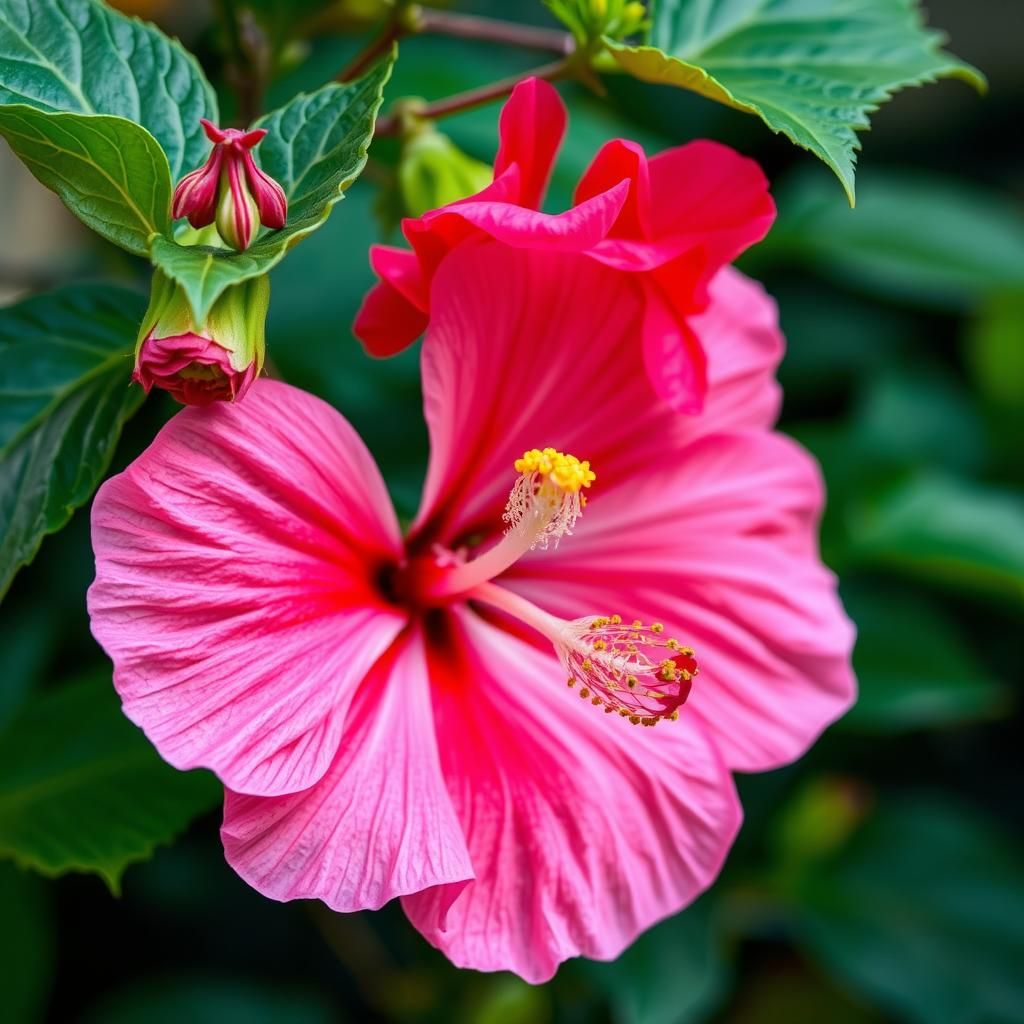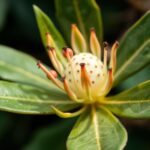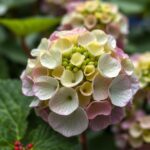Discover the Beauty and Care of Hibiscus Hibiscus Rosa Sinensis: Your Ultimate Guide

Hibiscus rosa sinensis, commonly known as hibiscus, is a stunning flowering plant cherished for its vibrant blooms and lush foliage. This tropical beauty not only enhances gardens and landscapes but also offers numerous benefits, from its medicinal properties to its role in enhancing local ecosystems. In this ultimate guide, we will explore the captivating characteristics of hibiscus, delve into effective care tips, and uncover the best practices for growing this magnificent plant. Whether you're a seasoned gardener or a novice enthusiast, embracing the beauty and care of hibiscus will elevate your gardening experience and enrich your surroundings.
The Beauty and Benefits of Hibiscus (Hibiscus rosa-sinensis)
Hibiscus (Hibiscus rosa-sinensis) is a stunning tropical plant known for its large, vibrant flowers that can be found in various colors such as red, pink, white, and yellow. The plant is not only admired for its striking aesthetic appeal in gardens and landscapes but also for its potential health benefits. Rich in antioxidants, hibiscus has been used in traditional medicine for centuries, aiding in the management of high blood pressure, improving digestion, and promoting weight loss. Additionally, its flowers can be used to make herbal teas that are often praised for their refreshing taste and numerous nutritional properties. This plant thrives in warm, tropical climates, making it a popular choice among gardeners looking to cultivate an exotic touch in their outdoor spaces.
Cultural Significance of Hibiscus
The hibiscus flower holds significant cultural importance in various regions around the world. In Hawaii, for instance, it symbolizes hospitality and is often worn by women in their hair as a sign of welcoming. In India, hibiscus is associated with Goddess Kali, who is believed to favor the flower in rituals. Its use in traditional celebrations and as a local adornment highlights its integral role in the cultural heritage of many communities. As such, hibiscus is not merely a plant; it represents identity and tradition across diverse cultures.
Health Benefits of Hibiscus Tea
Hibiscus tea, made from the dried petals of the Hibiscus rosa-sinensis, is renowned for its numerous health benefits. Rich in vitamin C and antioxidants, it helps in boosting the immune system and fighting off infections. Studies have indicated that hibiscus tea can aid in reducing blood pressure and cholesterol levels, making it beneficial for individuals with cardiovascular concerns. Moreover, its diuretic properties assist in detoxification, promoting kidney health and improving digestion. As such, incorporating hibiscus tea into daily routines can contribute significantly to one's overall well-being.
Growing Hibiscus: Tips for Cultivation
Cultivating hibiscus requires some specific conditions to thrive optimally. First and foremost, hibiscus prefers a full sun location, as it thrives on warm and bright environments. The soil should be well-drained and rich in organic matter to ensure healthy growth. Regular watering is essential, especially during dry spells, but care should be taken to avoid waterlogging. Pruning the plant can also encourage bushier growth and more blooms. By providing the right conditions and care, gardeners can enjoy the lush and beautiful presence of hibiscus in their landscapes.
Hibiscus in Skincare
Hibiscus is not only valuable for its health benefits but also plays a significant role in skincare. The flower is often referred to as the natural botox due to its ability to improve skin elasticity and promote a youthful appearance. Its antioxidant properties help in combating free radicals, reducing signs of aging. Hibiscus extracts are commonly found in various skincare products, providing hydration and nourishment to the skin. Furthermore, its natural acidity can help with exfoliation, making it a popular ingredient for DIY beauty treatments.
Culinary Uses of Hibiscus
In addition to its therapeutic properties, hibiscus is widely used in culinary applications across various cuisines. The petals of hibiscus can be used to prepare salads, jams, and syrups. In many cultures, the flowers are cooked and served as a vegetable dish. Dried hibiscus can also be used as a flavor enhancer in beverages, providing a tart and refreshing taste. Additionally, hibiscus is a popular ingredient in drinks such as Agua de Jamaica in Mexico, showcasing its versatility and ability to enhance culinary creativity.
| Aspect | Description |
|---|---|
| Cultural Significance | Represents hospitality and is integral in rituals. |
| Health Benefits | Reduces blood pressure and boosts immunity. |
| Growing Conditions | Requires full sun and well-drained soil. |
| Skincare | Improves elasticity and hydrates skin. |
| Culinary Uses | Used in salads, jams, and refreshing drinks. |
Does Hibiscus rosa-sinensis come back every year?
:strip_icc()/pink-hardy-hibiscus-moscheutos-flowers-2a36cd01-36ebc92c05e249f78d1e899362b2480f.jpg)
Hibiscus rosa-sinensis, commonly known as the Chinese hibiscus or shoe flower, is a perennial plant that can come back every year in suitable climates. However, its ability to thrive year after year depends largely on environmental factors, care, and regional climate conditions. In USDA hardiness zones 9 through 11, Hibiscus rosa-sinensis will typically survive the winter and bloom again in the spring. In cooler climates, this plant may be grown as an annual or be brought indoors during frost.
Perennial Nature of Hibiscus rosa-sinensis
Hibiscus rosa-sinensis is classified as a perennial shrub, which means it can live for multiple years under the right conditions. To ensure that it returns each year, there are several factors to consider:
- Climate: It thrives in warm temperatures and does not tolerate frost well.
- Watering: Regular watering is crucial, but over-watering can lead to root rot.
- Soil Quality: Well-drained, nutrient-rich soil supports its growth.
Factors Affecting Survival
The survival and return of Hibiscus rosa-sinensis from year to year are influenced by multiple factors:
See also:
- Frost Protection: In colder regions, protection from frost is essential during winter months.
- Sunlight Exposure: It requires full sun for optimal growth and flowering.
- Pests and Diseases: Regular monitoring for pests like aphids and diseases can prevent damage.
Indoor vs. Outdoor Growth
When grown indoors, Hibiscus rosa-sinensis can be kept year-round, provided with adequate light and care. Key considerations include:
- Lighting: Use grow lights if adequate sunlight isn't available.
- Humidity: Keeping humidity levels high helps in maintaining the health of the plant.
- Temperature Control: Indoor settings should maintain warm temperatures to prevent stress on the plant.
Seasonal Care Tips
To encourage strong regrowth each year for Hibiscus rosa-sinensis, implement these care tips:
- Pruning: Regularly prune dead or diseased branches to promote new growth.
- Fertilization: Use a balanced fertilizer during the growing season to enhance blooming.
- Mulching: Apply mulch to retain moisture and regulate soil temperature.
Signs of Return
To determine if your Hibiscus rosa-sinensis will return, look for these signs as spring approaches:
- New Leaf Growth: The emergence of fresh leaves indicates the plant is awakening from dormancy.
- Buds Formation: Flower buds appearing are a positive sign of an imminent bloom.
- Vibrant Stems: Healthy, green stems suggest that the plant is alive and ready to grow.
Is Hibiscus rosa-sinensis an indoor or outdoor plant?

Hibiscus rosa-sinensis, commonly known as the Chinese hibiscus or tropical hibiscus, can be both an indoor and outdoor plant, depending on the climate and care conditions. This tropical plant thrives in warm temperatures and requires plenty of sunlight, making it more suitable for outdoor environments in regions with temperate to tropical climates.
However, it can also be grown indoors in colder climates or during winter months when temperatures drop. When grown indoors, it requires a bright location, usually near a window, to ensure adequate light. The plant can adapt to indoor conditions but may require extra attention to humidity and watering.
Growing Conditions for Hibiscus rosa-sinensis
Hibiscus rosa-sinensis has specific growing conditions to flourish successfully. Here's what it needs:
- Light: It thrives in bright, indirect sunlight and requires at least 6 hours of light a day.
- Temperature: The ideal temperature range is between 60°F to 85°F (15°C to 29°C). Temperatures below 50°F (10°C) can be detrimental.
- Soil: Well-draining, nutrient-rich potting soil is essential for growth.
Indoor Caring Tips for Hibiscus rosa-sinensis
For homeowners who wish to grow Hibiscus rosa-sinensis indoors, special care is required:
- Watering: Ensure the soil is consistently moist but not waterlogged. Water thoroughly when the top inch of soil feels dry.
- Humidity: Indoor environments can be dry; using a humidifier or placing the pot on a tray of wet pebbles can help.
- Fertilizing: Apply a balanced fertilizer every few weeks during the growing season to promote blooming.
Outdoor Considerations for Hibiscus rosa-sinensis
When growing Hibiscus rosa-sinensis outside, consider the following aspects:
- Location: Choose a site with full sun exposure for optimal blooming and growth.
- Spacing: Ensure enough space between plants to allow for airflow and light penetration.
- Protection: In regions with cold winters, protect the plant by covering it or bringing potted specimens indoors.
Common Pests and Diseases
Hibiscus rosa-sinensis is susceptible to various pests and diseases, which can affect its health:
- Aphids: Small sap-sucking insects that can cause damage and must be treated with insecticidal soap.
- Powdery Mildew: A fungal infection that appears as white spots and can be mitigated by improving air circulation.
- Spider Mites: These tiny pests thrive in dry conditions and can be controlled with increased humidity and treatments.
Blooming Season and Care
Understanding the blooming season and how to care for Hibiscus rosa-sinensis will enhance its aesthetic appeal:
See also:
- Season: Typically blooms in warmer months, from spring to fall, with vibrant flowers.
- Pruning: Pruning after flowering encourages bushier growth and more blooms in the next season.
- Deadheading: Regularly remove spent blooms to promote continuous flowering and improve plant health.
Does Hibiscus rosa-sinensis like sun or shade?
:max_bytes(150000):strip_icc()/caring-for-hibiscus-847914_final-08a34e40b9ca4e45ae875a22f03d30fb.jpg)
Hibiscus rosa-sinensis, commonly known as the Chinese hibiscus or tropical hibiscus, thrives best in full sunlight. This plant is a tropical species that requires warm temperatures and ample light to flourish. Here, we will explore its light preferences in detail, discussing why it prefers sunlight, how to care for it, the effects of shade, and variations in different climates.
Light Requirements
Hibiscus rosa-sinensis generally prefers sunny locations where it can receive direct sunlight for at least 6-8 hours per day. The exposure to sunlight encourages robust growth, vibrant flower production, and overall plant health.
- Full Sun: Optimal for blooming and vigorous growth.
- Partial Shade: Can tolerate some shade, reducing blooming capacity.
- Avoid Dark Locations: Insufficient sunlight can stunt growth and result in fewer flowers.
Effects of Insufficient Sunlight
When Hibiscus rosa-sinensis is grown in shaded conditions, it may not bloom as profusely as it would under full sun. Leaves may become sparse, and the plant could exhibit weak growth, becoming leggy as it stretches for light.
- Reduced Flowering: Less sunlight leads to fewer blossoms.
- Weak Growth: Stunted development can occur.
- Increased Pests: Shadier conditions may attract pests and diseases.
Optimal Conditions for Growth
To ensure that Hibiscus rosa-sinensis thrives, it’s essential to provide the right mix of sunlight and warmth. Best results are often seen in climates that mimic its native tropical environment.
- Warm Temperatures: Prefers temperatures between 60°F to 90°F (15°C to 32°C).
- Well-draining Soil: Use a mix that retains moisture but allows excess water to escape.
- Regular Watering: Maintain consistent moisture without waterlogging.
Seasonal Variations
Depending on the season, the light conditions may change drastically. Understanding how to adjust care routines is crucial for maintaining healthy plants throughout the year.
- Summer Sun: Ensure that the plant has protection during extreme heat to avoid scorched leaves.
- Winter Care: In cooler months, consider temporary relocation to an area that receives ample light.
- Compensating Shade: During peak summer, partial shade can be beneficial to prevent damage.
Container vs. Ground Planting
When grown in containers, Hibiscus rosa-sinensis can be relocated to optimize sunlight exposure. This adaptability is particularly useful in areas with fluctuating light conditions.
- Portability: Easily moved to seek out the best sunlight.
- Microclimate Control: Position can be adjusted according to seasonal changes.
- Enhanced Air Circulation: Helps prevent fungal diseases which can occur in shaded areas.
Questions from Our Readers
What are the primary benefits of hibiscus (Hibiscus rosa sinensis)?
The primary benefits of Hibiscus rosa sinensis include its ability to support immune health, improve skin appearance, and provide natural antioxidants. Its vibrant flowers are not only visually appealing but also offer various medicinal properties, making it a popular choice in herbal remedies.
How do you care for a Hibiscus rosa sinensis plant?
Caring for a Hibiscus rosa sinensis plant involves ensuring it receives adequate sunlight, maintaining a consistent watering schedule, and using a well-draining soil mix. Fertilizing regularly during the growing season and pruning after flowering can also help promote healthy growth and abundant blooms.
Can Hibiscus rosa sinensis be grown indoors?
Yes, Hibiscus rosa sinensis can be grown indoors, provided it receives sufficient light and warmth. It's essential to place the plant near a south-facing window and ensure it is kept in conditions that mimic its native tropical environment to thrive indoors.
Is Hibiscus rosa sinensis safe for pets?
Generally, Hibiscus rosa sinensis is considered safe for pets, especially cats and dogs, as it is non-toxic. However, it is always advisable to monitor your pets to ensure they do not consume large quantities, as this could cause a mild gastrointestinal upset.
See also:

If you want to read more articles like Discover the Beauty and Care of Hibiscus Hibiscus Rosa Sinensis: Your Ultimate Guide, we recommend you check out our Shrubs category.
Leave a Reply
Related Articles